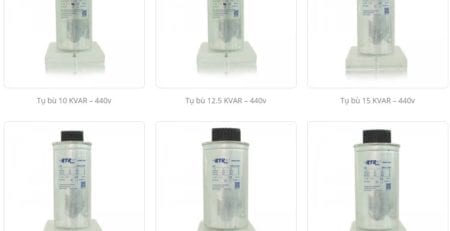Construction of high voltage compensating capacitors
High-voltage capacitors are also known as high-voltage capacitors
- Uses of capacitors high voltage ?
– Supply reactive power Q to the grid, thereby improving the power factor Cosφ on the grid, leading to reduced power loss on the grid.
– Contribute to voltage regulation and voltage stabilization for the power network.
- Construction of capacitors high voltage ?

Figure High voltage compensating capacitor
High-voltage capacitors are constructed of two thin aluminum foil pole plates, lined with thin layers of insulating paper, rolled (or flattened), placed in a thin tin-sealed container filled with oil. With special insulation, the wire ends are soldered on two pole plates and brought out by two insulating bushings caught on the top of the case. Usually high voltage capacitors are made from several tens to several hundred KVAR at voltages from 3-35-110kV.
- Capacitor parameters high voltage ?
The parameters of the capacitor are:
Udm : Rated working voltage of the capacitor ( kV )
Cdm : Capacitor capacitance ( μF )
fdm : Rated working frequency ( Hz )
Qdm : Rated reactive power ( KVAR )
- What is vertical offset, the effect of vertical offset ?
– Vertical compensation is a method of connecting compensating devices, usually static capacitors (or synchronous compensators) to the power transmission lines used in remote transmission systems.
– The effect of vertical compensation is to change the reactance value of the line, the purpose is to reduce voltage loss on the line and help increase the voltage stability of the system when there is a fault.
- What is horizontal offset, the effect of horizontal offset ?
– Horizontal compensation is a method of connecting compensating devices (static capacitors, or synchronous compensators) to the power transmission and distribution grid.
– The effect of horizontal compensation is to compensate for the reactive power on the line, to improve the power factor Cosφ, leading to an increase in the load capacity of the active power on the line, helping to reduce transmission loss and contributing to the control of the transmission line. Regulate and stabilize the voltage of the power supply grid.
- Connection capacitors How high is the voltage to the grid?
– Y star connection
– Triangle connection ∆
- Protection for high voltage capacitors, precautions when working with high voltage capacitors ?
Depending on the original design and installation, It is usually most effective that each capacitor on the line phase is protected by a self-falling fuse, with the rated current of the protective fuse not exceeding more than 110% of the rated current of the capacitor. If a capacitor is connected to the mains through a circuit breaker, the rated current for protection for the whole group of capacitors is not to exceed 120% of the rated current of the whole group of capacitors.
- Compare advantages and disadvantages of synchronous compensators with capacitors ?
| Capacitor compensation | Synchronous Compensator |
| – As a static device, It is easy to install, operate and maintain. – Made in small units, so the assembly is convenient according to the requirements of the load and high efficiency. – Poor construction is sure to be easily damaged in the event of an accident. – Sensitive to voltage fluctuations, when the voltage rises above 110%Udm of the capacitor, the capacitor is very easily punctured, the only secondary ability is to raise the voltage for the network. – Low power consumption. – Low cost. |
– As a rotating machine, assembly, operation and maintenance are difficult – Usually manufactured with large capacity, so It is only suitable in places where concentrated compensation is required with large capacity. – Solid construction. – Synchronous compensators work depending on the excitation mode, can provide or consume reactive power of the grid, so It is also used to adjust voltage for very good power. – Consumes a lot of power. – High investment and maintenance costs |








Leave a Reply